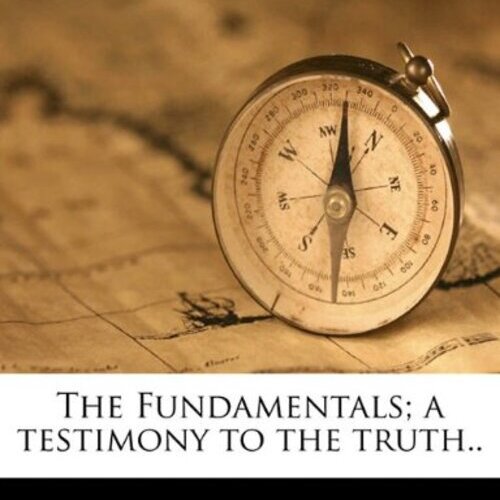Fundamentalism has become an ugly word. Fiery and steadfast preachers of years past rallied around this term as a banner to be held high above their fight to hold the ground of biblical truth. But in recent years, fundamentalism has been marred by scandal, narrow-minded theology (that often lacks biblical scholarship), isolationism, and petty squabbles over positional statements. For some that grew up in this environment and were disillusioned by it, they have either moved on to more “modern” or “inclusive” churches or have simply written off church altogether. There is no question that modern fundamentalism has some ground to make up, some wrongs to make right, and perhaps even some standards that need loosened up. However, is it time to put fundamentalism in the rear-view mirror, wave goodbye, and just move on?
To answer this, let’s examine the origin of the movement itself. It was the late 1800’s when fundamentalism first began its modern-day journey. New discoveries were being made in biblical archaeology, new theories were being developed about the Bible, and new scholars and academics had begun pushing a new biblical philosophy referred to at the time as “modernism”. The new biblical philosophies that were creeping into theological seminaries and into many denominations screamed of heresy: denying the virgin birth of Jesus Christ, denying His resurrection, denying the authority of the Scriptures, and redefining the sinful nature of man (to name a few). The tension between “modernist” and “traditionalist” views continued over the years until a series of books were completed around 1915 titled The Fundamentals: A Testimony to the Truth. This volume defined the fundamentals of biblical Christianity that the “traditionalists” said could not be compromised. The key doctrines laid out in these books would become a dividing line in our country and those that held to them began to be called “fundamentalists”. The fundamentalist movement was not merely a Baptist movement. It swept across many denominations in our country. All who affirmed these fundamentalist doctrines created a loose-knit alliance of churches who were willing to take a stand for biblical truth.
Over the past 100 years or so, fundamentalism has taken a number of twists and turns. Different camps emerged that held to a particular additional standard or conviction. For some, it became harder to agree on things and, as separation was a key tenet of being fundamentalist, they found reasons to separate from each other over one point or another. Oftentimes, churches got stuck with methods, standards and convictions that were decades behind where society was moving. Meanwhile, liberal churches (while not always agreeing on doctrine between themselves) had a general agreement about modern “scholarship” and continued to adapt their methods to reach a modern era. These modern churches created programs, removed established decorum, and adapted music in their worship that related well to the culture. However, being devoid of teaching the fundamental truths of Scripture, they were offering a religious experience and some self-help psychology without preaching the transformational message of Christ’s sacrifice for sin.
Where does that leave the fundamentalists today? Unfortunately, it has left many churches marginalized by our culture and dwindling in membership. We can’t always avoid that as the truth is offensive to those who aren’t living according to it. However, we have often been so focused on the “extras” of fundamentalism that we have neglected to focus on what really matters. Here are two simple suggestions that would make a world of difference to restore this once-great movement:
First, let’s just admit that we can’t fellowship with everyone. We are told to separate from sin as well as those who preach unbiblical falsehoods. This is, by necessity, going to limit where alliances can be made. However, we also must recognize that the fundamentals are what truly matters and finding some reason to separate is not a sign of spirituality. There are many Christians in many denominations who hold to these key doctrines and know the Lord as Savior. As Jesus said in Luke 9:50 – “He that is not against us is for us.”
Second, we need more Christians and churches to stand up for these fundamentals of the faith. Wouldn’t it be a wonderful testimony to see a great coalition of diverse churches from across our land “sign-on” to these fundamental truths and commit to defending them? As an individual, you may be at a church which offers an uplifting worship experience, has friendly people, and a dynamic pastor, but have you examined the truth that they stand for? Ask for their doctrinal statement. Observe if the doctrines they claim are actually being applied. Are you willing to draw a dividing line on the fundamentals and then make the hard relational choices to separate yourself from the church whose doctrine has gone astray?
Fundamentalism may still be an ugly word for some of you. Perhaps we need to change the title – but we must never change the truth. Fundamentalism is not dead and it is not lost. It may have wandered and neglected to stay in touch with a changing society. It may have strayed and become pharisaical in some areas. It may have been shepherded by leaders that were bigoted, narrow-minded, unnecessarily divisive and even abusive at times. But at the root of fundamentalism are core doctrinal truths that must not be compromised and are worth the cost to defend. May we get back to our roots once again.
P.S. - While I don't necessarily agree with all of the stances or conclusions in these books, here are some resources that will help to fill in the details about the fundamentalist movement for further reading:
- The Fundamentals: A Testimony to the Truth, edited by R.A. Torrey, ISBN-13 - 978-0801012648
- The Church of the Fundamentalists: An Examination of Ecclesiastical Separation in the Twentieth Century, Dr. Larry Oats, ISBN-13 - 978-0982142622
- "Recovering" Part 4 - Whose Fault Is It?

